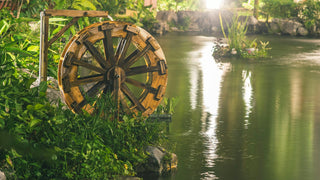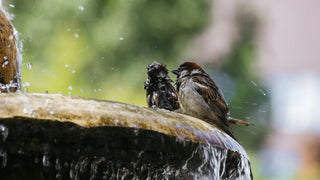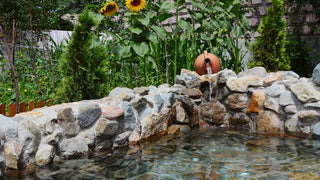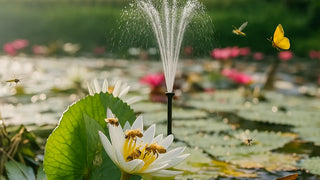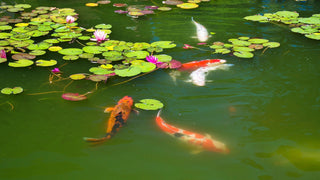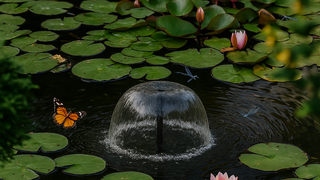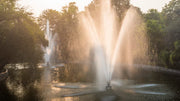
A garden fountain will completely change the atmosphere of an outdoor space. The water flow brings light and noise, and before long, wildlife begins to take interest as well. Birds will be the first to arrive. They drink, bathe, and even tend to hang around nearby branches for a bit. But here's something most individuals don't think about: if the fountain jet is too powerful, it can actually drive away birds instead of attracting them.

If your goal is to create a welcoming space for wildlife, fountain design is equal to what type of vegetation you choose. Let's explore more about how fountain power birds dynamics work, safe flow and depth options, and the ways to tune your setup so that you and your bird friends are happy.
The Impact of Fountain Power on Birds
Birds approach water cautiously. A robin or finch will linger at the perimeter before leaping in. If the water is softly bubbling, they're fine. If it's shooting up in a high spray, all the noise and splashing may be too much. Small birds particularly shun fountains that appear or sound aggressive.
Excessive pressure isn't just an aesthetic issue—it changes the functioning of the space:
- Loud splashing scares shy birds.
- Strong jets waste water and destroy shallow pools where birds prefer to wade.
- Bathing is clumsy if ripples are too strong.
The key to effective bird fountain design is to mimic the sound and movement of a natural puddle or stream. A gentle trickle invites from far away, but a raging spray does just the opposite.

Safe Depth and Flow Rate
Depth is also something that most beginner pond owners underestimate. Most garden birds like water no deeper than 2–3 inches for bathing purposes. They're not swimmers—they love to splash water onto their wings when standing firmly rooted. A reliable rule of thumb is to have at least part of the fountain or pond rim remain at 2–3 inches deep. Larger birds, like blackbirds or doves, will tolerate a little deeper water, but even in those situations, shallow ledges provide them with a greater sense of security.
Flow rate must be calibrated to gentle circulation. Think about the distinction between a bubbling spring and a fire hydrant. Birds prefer the former. A low bubbler nozzle or mushroom-type dome triggers movement but does not overwhelm the basin. For anybody with fountain wildlife safety in mind, this compromise of depth and flow is essential.
Poposoap Adjustment Mode
One of the benefits of modern Poposoap fountains is their ease of adjustment. Most have adjustable flow and replaceable nozzles. That means you don't need to resort to "too strong" or "off." You can lower the water pressure to suit wildlife and still ensure circulation health.
On sunny days, for example, you may have a low bubbler head running to usher in birds. During hot weather when algae risk is in danger, you may switch to a slightly higher power for higher oxygenation. For solar-powered models, battery backup covers gaps during cloudy periods, providing even water circulation without surges. Such a degree of flexibility makes Poposoap products very easy to use in wildlife gardens.
Setting Suggestions
These are some working guidelines for installing a fountain to delight birds:
- Keep spray low. Less than a foot is usually preferable for most birds.
- Provide landing places. Flat rocks or gently sloping rims offer birds secure footing.
- Think about cover. Place the fountain where shrubs or trees are in easy reach so birds have handy escape routes, but not so close that predators will have cover.
- Seasonal adjustments. Spring and summer are the busiest periods of time for birds. Slow the flow during these months to encourage bathing. In autumn, when there are more leaves, a bit more flow will keep the basin clear of them.
- Maintenance is essential. Regularly clean the nozzles. Clogged jets create unbalanced or distorted sprays that confuse wildlife.
At the above settings, your fountain becomes more than a simple ornament to become a working part of the habitat.
Bird Behavior Observation
The best way to know that your fountain is working is just to watch. Birds will tell you by their behavior.
- When they successfully bounce into shallow spots, splash, and return often, you've succeeded.
- If they flit around but never land, or land for a brief moment then leave again, the stream may be too strong.
- If visits decline over time, it’s worth checking not only fountain settings but also surrounding cover and predator presence.
Observation is at the heart of bird fountain design. No setting is perfect forever—you’ll find yourself adjusting season by season as the garden changes and wildlife responds.
Conclusion
An aggressive fountain might be dramatic for us, but it is not necessarily pleasing to wildlife. Birds prefer subtle movement, shallow depth, and uniform condition. Being careful to note flow, depth, and adjustability will assist you in finding a balance of beauty and ecology.
With Poposoap's adjustable pumps, interchangeable nozzles, and solar-driven units, it's never easier to design a system that provides both beauty and fountain wildlife safety. The next time you wonder whether your fountain is too strong, watch the birds. They'll instruct you exactly what does—and once they're safe, your garden will come alive.





